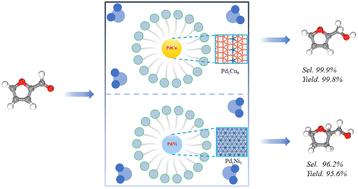当前位置:
X-MOL 学术
›
Green Chem.
›
论文详情
Our official English website, www.x-mol.net, welcomes your
feedback! (Note: you will need to create a separate account there.)
Composition control of Pd-based bimetallic alloys to boost selective hydrogenation of furfural in aqueous micelles
Green Chemistry ( IF 9.3 ) Pub Date : 2023-12-06 , DOI: 10.1039/d3gc03357k Yiru Chen 1 , Xi He 1 , Ming Zhang 2 , Lixin Chen 1 , Xuemin Liu 1 , Bing Liu 1 , Hengquan Yang 2 , Xin Ge 1, 3
Green Chemistry ( IF 9.3 ) Pub Date : 2023-12-06 , DOI: 10.1039/d3gc03357k Yiru Chen 1 , Xi He 1 , Ming Zhang 2 , Lixin Chen 1 , Xuemin Liu 1 , Bing Liu 1 , Hengquan Yang 2 , Xin Ge 1, 3
Affiliation

|
Composition control of bimetallic alloys to regulate the hydrogenation of furfural into high value-added derivatives is an important strategy for catalyst design, but remains a great challenge. In this work, we present a simple and sustainable strategy to construct Pd-based bimetallic alloys by reducing metal precursors dissolved in an aqueous solution of the sugar-based surfactant GluM. An obvious elemental composition-dependent selective hydrogenation of furfural in GluM aqueous micellar solution was observed – the Pd1Cu9 alloy exhibits a remarkable selectivity (99.9%) to furfural alcohol, whereas the Pd1Ni3 alloy can achieve deep-hydrogenation to tetrahydrofurfuryl alcohol with a high selectivity (96.2%). Experimental and theoretical investigation indicated that the excellent selectivity was attributed to the alloy effect and solvent effect, which provide different dissociative adsorption abilities of H2 on the surface and the hydrogen bonding interactions facilitating H transfer in aqueous micelles, respectively. Notably, GluM micelles are not only employed to stabilize Pd-based bimetallic alloys, but also to enrich the furfural in water to improve the hydrogenation catalytic activity. Besides, this work on bimetallic alloy composition and H-shuttle in aqueous phase provides a new research direction for selective hydrogenation of furfural.
中文翻译:

钯基双金属合金的成分控制促进水胶束中糠醛的选择性加氢
通过控制双金属合金的成分来调节糠醛加氢生成高附加值衍生物是催化剂设计的重要策略,但仍然是一个巨大的挑战。在这项工作中,我们提出了一种简单且可持续的策略,通过减少溶解在糖基表面活性剂 GluM 水溶液中的金属前体来构建 Pd 基双金属合金。在 GluM 胶束水溶液中观察到糠醛明显的元素组成依赖性选择性氢化反应 - Pd1Cu9 合金对糠醛醇具有显着的选择性(99.9%),而Pd1Ni< a i=7>3合金可以深度加氢生成四氢糠醇,选择性较高(96.2%)。实验和理论研究表明,优异的选择性归因于合金效应和溶剂效应,它们在表面提供了不同的H2解离吸附能力,氢键相互作用分别促进水性胶束中的氢转移。值得注意的是,GluM胶束不仅用于稳定Pd基双金属合金,还可以富集水中的糠醛以提高加氢催化活性。此外,双金属合金成分和水相H-穿梭的研究工作为糠醛选择性加氢提供了新的研究方向。
更新日期:2023-12-06
中文翻译:

钯基双金属合金的成分控制促进水胶束中糠醛的选择性加氢
通过控制双金属合金的成分来调节糠醛加氢生成高附加值衍生物是催化剂设计的重要策略,但仍然是一个巨大的挑战。在这项工作中,我们提出了一种简单且可持续的策略,通过减少溶解在糖基表面活性剂 GluM 水溶液中的金属前体来构建 Pd 基双金属合金。在 GluM 胶束水溶液中观察到糠醛明显的元素组成依赖性选择性氢化反应 - Pd1Cu9 合金对糠醛醇具有显着的选择性(99.9%),而Pd1Ni< a i=7>3合金可以深度加氢生成四氢糠醇,选择性较高(96.2%)。实验和理论研究表明,优异的选择性归因于合金效应和溶剂效应,它们在表面提供了不同的H2解离吸附能力,氢键相互作用分别促进水性胶束中的氢转移。值得注意的是,GluM胶束不仅用于稳定Pd基双金属合金,还可以富集水中的糠醛以提高加氢催化活性。此外,双金属合金成分和水相H-穿梭的研究工作为糠醛选择性加氢提供了新的研究方向。





















































 京公网安备 11010802027423号
京公网安备 11010802027423号